A letter to Albert Barkas, Chief Librarian
I found a letter, sent to Albert Barkas, glued into our copy of the book The Private Palaces of London. The letter was sufficiently intriguing to prompt some detective work into the backgrounds of the recipient, the book, the author and his father who had donated it to Richmond Library. Our Online Information Library and the Richmond upon Thames Local Studies Library and Archive provided the resources.
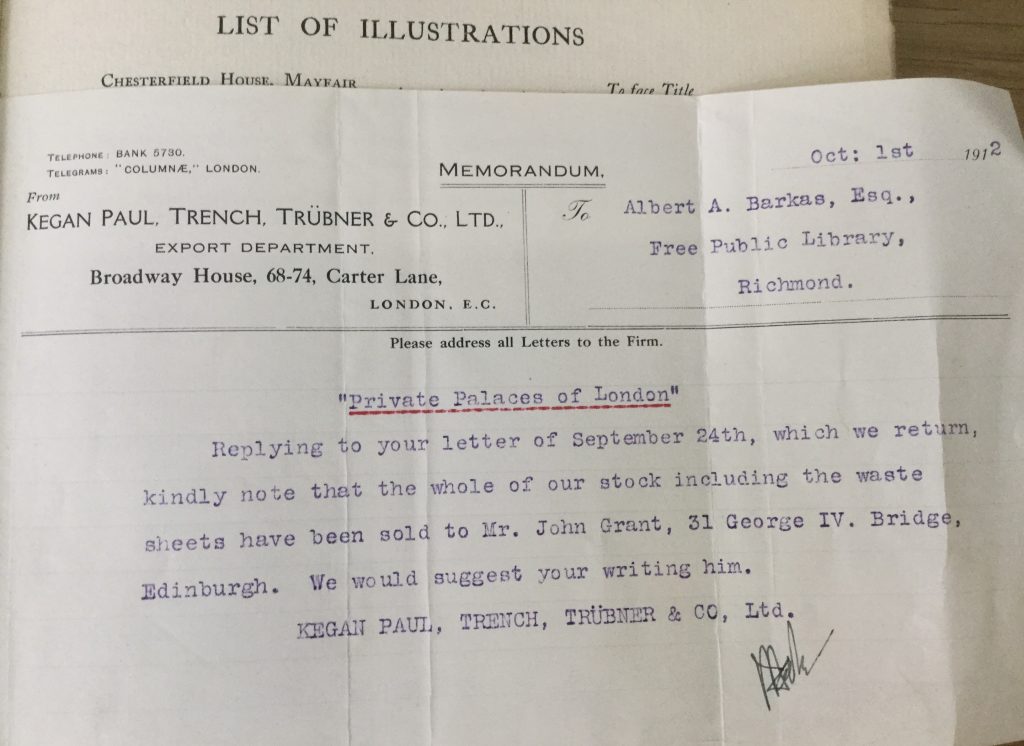
Private Palaces of London
The book The Private Palaces of London is in the Information & Reference Library Reserve Store. It was written by Edwin Beresford Chancellor and was donated to Richmond Libraries by his father, Albert Chancellor, who was a Richmond resident. The book describes the great houses of London, both existing and demolished, and includes photographs and illustrations.
It was published by Keegan Paul, Trench, Trubner & Co in 1908. (Initially, Truber had an umlaut over the u but it was dropped after the First World War). The Carter Lane address housed their export department and the lane is located between St. Paul’s Cathedral and the River Thames. In 1912 the company merged with Routledge to become Routledge & Kegan. Routledge is still in existence today and a reference in the Times Digital Archive reveals that Keegan Paul, Trench, Trubner & Co continued as booksellers and were still operating in the late 1960s.
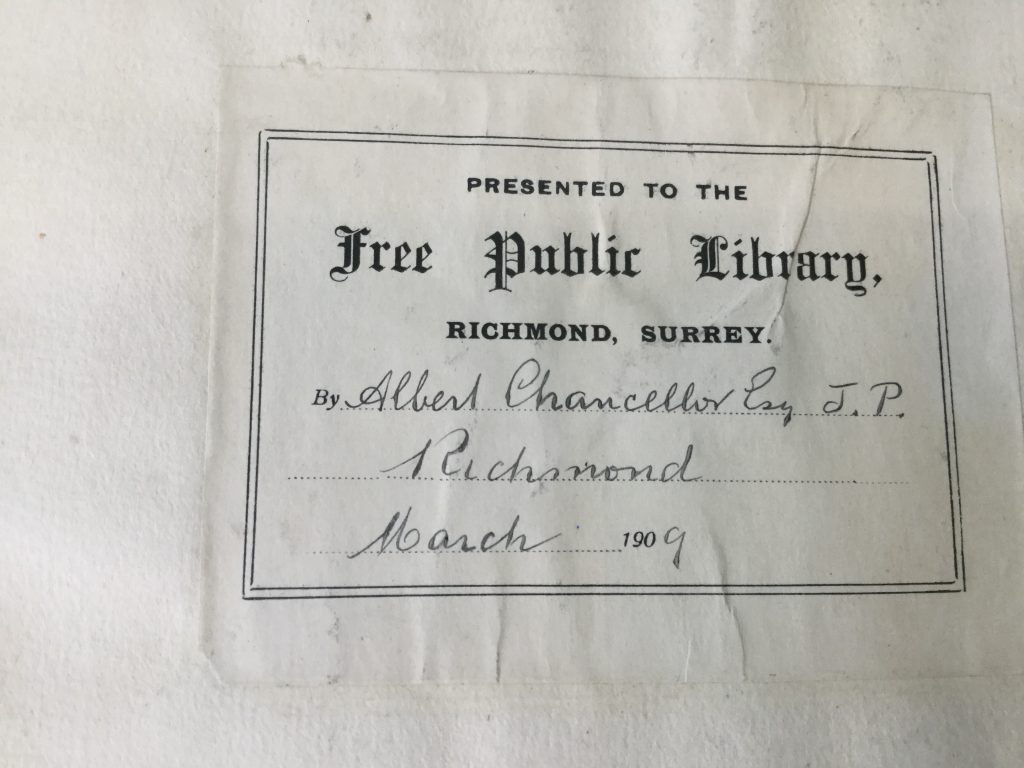
Publishers and booksellers
The John Grant referred to was a bookseller and publisher, and it was he who bought the waste sheets and copies of the book. His sons and nephew continued in the business until the 1970s and the Edinburgh address, 31 George IV Bridge, is in the Old Town and runs southwards from the High Street. It is also where the National Library of Scotland is located. It was and is quite usual for publishers to sell stock that is no longer selling to booksellers in order to clear room in their warehouse and to recoup some of the publishing costs. This process is known as remaindering.
Albert Chancellor
The book was donated by the author’s father, Albert Chancellor JP. Our online subscription to Ancestry provided the following information:
He was born in 1842, at Hyde House, Battersea and was baptised on 30 November 1842 at St.Luke’s in Chelsea. Today there is a Hyde Lane just off Battersea Bridge Road, so Hyde House may have been here. He married Emma Ellen Theresa Beresford on 23 February 1867 at St. Mark’s, Regent’s Park. Edwin Beresford Chancellor was born in January 1868. On 1 September 1869 Albert was give the Freedom of the City because his father had received the award in 1822 and Albert was granted it through patrimony.
From the C19th Censuses
The Census provides a series of ten-year snapshots of Chancellor and his the family. Census night is usually in April.
- 1851 – No trace of him in this Census.
- 1861 – Albert was a lodger at 5 and 6 Newgate Street, London. His occupation is a little difficult to read but he could have been a traveller.
By 1871 he is married and living in Richmond.
- 1871 – The household consisted of his wife Emma, their two children. Edwin is 3 and Maude E is 1. His occupation is listed as estate agent and the household has a general servant and nurse and under-nurse. Their address was: 2 Retreat Villas (Retreat Road).
- 1881 – They are now living in Brighton at 49 Marine Parade, Kemp Town but we have no way of knowing why they moved. Chancellor is 38, Emma is 35, Edward B is 13 and is listed as being a scholar, Francis W is 2 months, and Maude isn’t with them. A nurse and a nursemaid are also listed.
- 1891 – The family are back in Richmond living at Ashburton House, The Hill. Albert is now an auctioneer. Mabel Rose is 16 and Albert is 17 and is an auctioneer’s clerk, presumably with his father’s firm.
From the C20th Censuses
- 1901 – Albert and Emma are now living at 174 Norfolk House, Kew Road. His occupation is listed as estate agent and surveyor. The only child still at home is Mabel Rose who is now 26.
- 1911 – The family are still at the same address but only Emma, now 68, and her daughter Mable Rose, 36, plus a nurse are listed. Chancellor was still alive (as he didn’t die until November). Unfortunately, there is now way of knowing who the nurse was looking after nor where Albert was on Census night.
From Kelly’s Street Directories
Street directories were published annually. They carried a list of private residents, a commercial directory, official information, and a street directory listing the head of the household. These directories helped to locate the whereabouts of the Chancellors in the years between the Censuses and the Local Studies Library and Archive has a collection of local street directories.
In the Directory for 1893 they are listed as living at Ashburton House, The Hill just as they were in the 1891 Census. The directory for 1896-7 shows that they had moved to Norfolk House, 174 Kew Road. The 1902-3 directory lists their telephone as no. 150 Richmond. Looking at the directory it is clear that not many people had telephones and the Chancellors must have been keen to obtain the new technology and have been able to afford it.
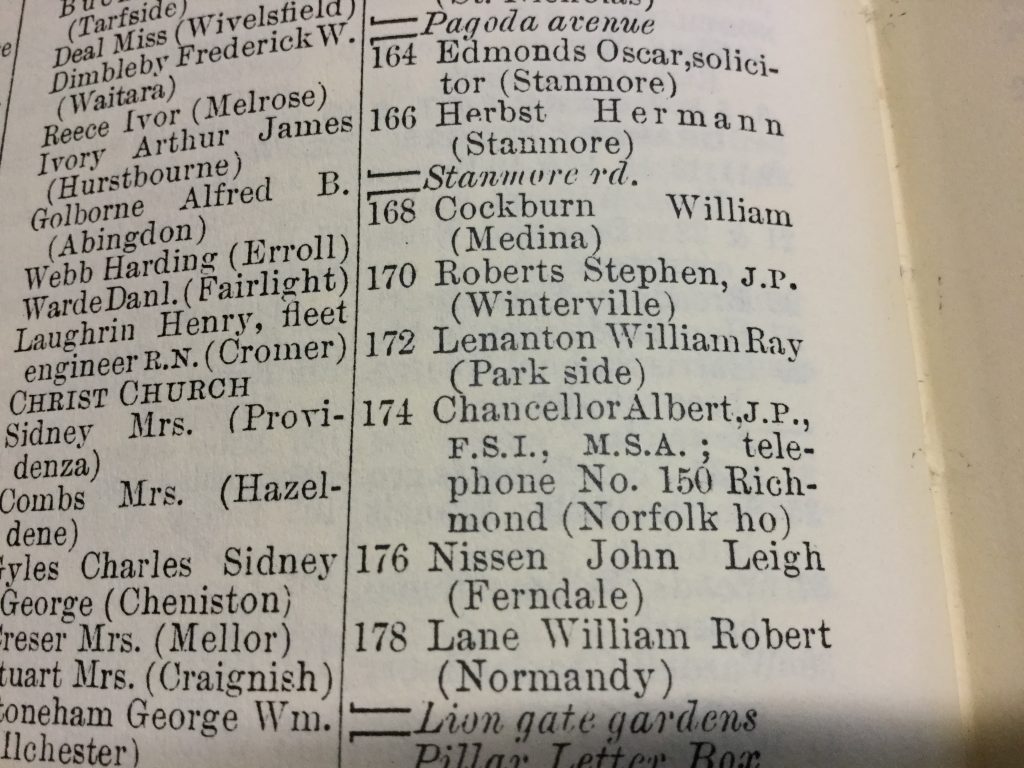
Municipal Diaries
The Local Studies Library and Archive holds a collection of municipal diaries which list councillors and committees, and a calendar giving the dates of the various meetings. We can assume that each councillor and selected council officers were provided with a copy. Today all such information is online.
Councillor and Mayor
Chancellor was a councillor for the Borough of Richmond, which was then part of Surrey. He represented both the West and the South wards and he was also Mayor in 1897 and in 1902. Richmond became a borough in in 1890, when it was granted its Charter of Incorporation and Sir John Whittaker Ellis was the first Mayor. The Town Hall (now the Old Town Hall1) stands on Whittaker Avenue, which was named after him. It houses the Information and Reference Library, the Local Studies Library and Archive, the Orleans House Gallery and the Museum of Richmond.
We do not hold a complete set of the diaries and though they cover the years 1893, 1894 there is a gap until 1903-4, so omitting the period of his Mayoralty. The diary for 1910-11 records that he was first elected in 1890 but did not serve continuously as a councillor. He was due to retire in 1913 but, sadly, he died in 1912. Chancellor sat on various committees including the Library Committee.
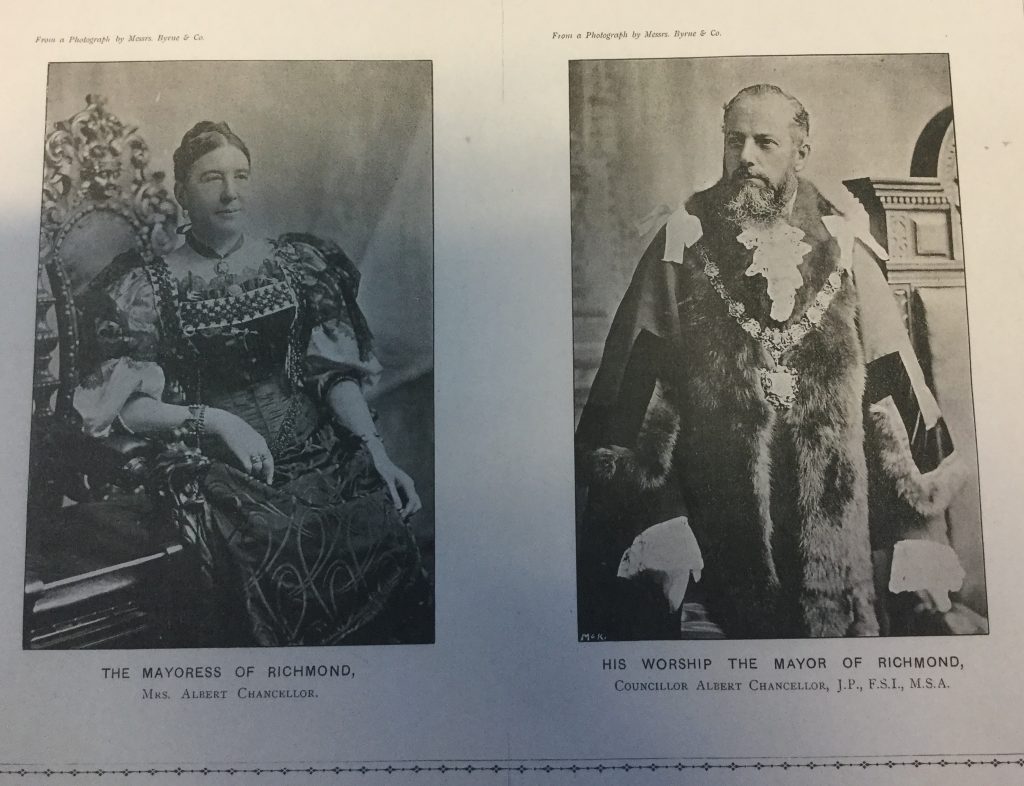
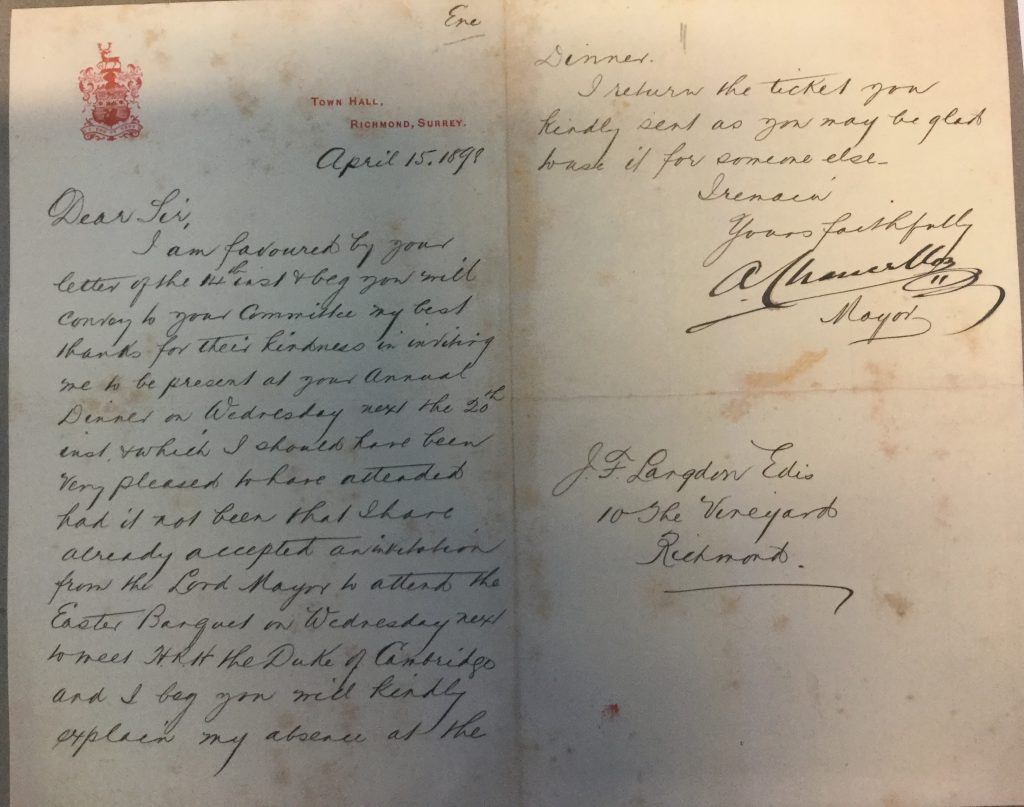
Chancellors and Sons
From an article in the Surrey Magazine (June 1903) we know that Chancellor moved to Richmond in 1863 and became manager of Messrs Chancellors and Sons, with his brother. He sunsequently became head of the firm after his brother’s death. Their premises were at 1 King Street in Richmond but it isn’t clear when the firm was started. It could have been that his brother was already living in Richmond.
Chancellors are still in existence as estate agents and have a branch in Richmond, with other branches across southern England.
The Times Digital Archive carries various references to Chancellor and his company, and includes advertisements for properties the firm was selling; a notable one being Pope’s Villa.
Chancellor’s Death
Chancellor’s obituary appeared in the Times (he died in November 1911), as did a bankruptcy notice. In the latter, Albert is listed as living at 6 Pembroke Villas although the Kelly’s Directory for 1911 records him as being at his Kew Road address. The 1912 directory, however, shows that Mrs Chancellor was living at 6 Pembroke Villas. Without much further investigation we cannot establish whether the Chancellors owned their residence in Kew Road, or whether moving from Norfolk House to Pembroke Villas was necessitated by financial problems.
Extracts from The Times
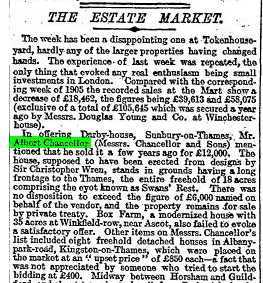
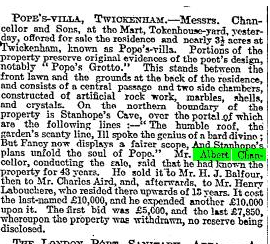
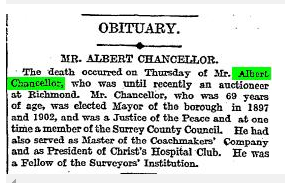
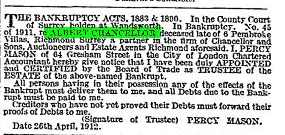
Edwin Beresford Chancellor
There are a a number of entries about Chancellor in the Times Literary Supplement and the Times Digital Archive, including reviews of his books, a notice of an auction of his books, letters he wrote to the The Times, and articles written by him. Having a distinctive name which made it easier to find references to him.

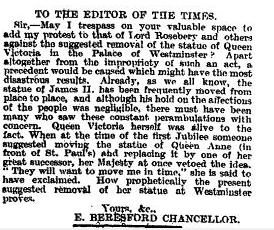
The genealogy resource, Ancestry, reveals that he was born in Richmond in 1868 and that he went to the University of Oxford. He is listed as a resident on 12 October 1888.
From the Census
- 1891 – No entries discovered
- 1901 – In this year Edwin is now married to Ellen, 34, and they have two children, Francis B Chancellor aged 3 and Richard AB aged 5. His occupation is listed as estate agent (employer) and the household includes a maid, cook and nursemaid. They live at 29 Church Park Gardens, Chelsea.
- 1911 – Edwin and Ellen are in Beckenham with her father. His occupation is now listed as author. The Census night that year was on 2 April – a Sunday. Could they have been visiting overnight?
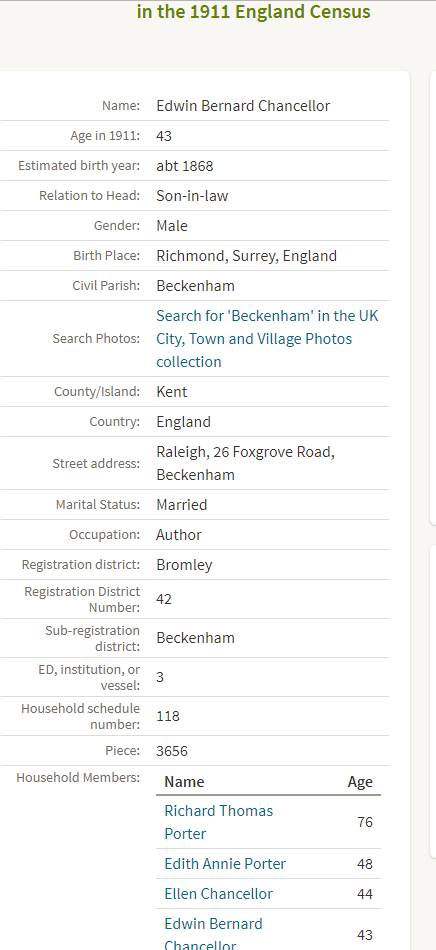
What happened to him after 1911?
We will have to wait until 2021, when the 1921 Census is released, to find out where they were in 1921. As we have focussed only on the resources available in Richmond upon Thames libraries we have not sought the street directories and electoral registers held at Kensington and Chelsea Local Studies and Archive which may reveal where the family lived after 1911.
We do know from Ancestry that he died on 4 February 1937. This information came from the National Probate Register which says he died in Kensington. It is possible that the local papers for that period may contain an obituary for him.
His writing
And while we know he was at the University of Oxford we do not know what he was studying. In 1885, his book Historical Richmond was published. In a note after the preface he states that he was unable to refer to the printed books in the British Library because he was 17 at the time of writing and students under 21 were not allowed access.
We hold some of his books in the Information and Reference Library Reserve Store and in our Local Studies collection, but a search of the British Library catalogue reveals that he was a prolific author. He seems to have been particularly interested in the history of London although he also wrote about architects and sculptors.
Albert Barkas
From various newspaper cuttings and a booklet, written by his granddaughter Joanna M Corbitt, we know the following about Albert Barkas.
He was born at 27 Roseville Street, St Helier, Jersey on 21 August 1861. His father was a librarian and bookseller and Barkas followed in his footsteps when he moved to England to take up a post of bookseller in Brighton. His wife to be, Anna, who also grew up in Roseville Street, trained as a piano teacher. In 1881 he found a position as a librarian at Birmingham Free Library and Anna eventually joined him. They were married on 15 September 1888 and their first child was born a year later.
Barkas comes to Richmond
In 1891 the post of Librarian for the Borough of Richmond, Surrey became vacant and Barkas’s application was successful. The family took up residence in the rent-free quarters above the library. Over the next few years three more children were born. But sadness hit the family when their youngest daughter Jacqueline died aged six years.
Death of Anna Barkas
Albert is described as having endless time for his children and being an indulgent father, an adoring husband and a gregarious man. His children remembered walks and picnics in Richmond Park, visits to Kew Gardens and watching cricket on the Green.
He was fascinated by local history and wrote articles, kept notes and lectured about the subject. His eldest daughter often accompanied him as he visited and photographed building and houses, often those that were due to be demolished, in Richmond and its environs. Anna, by contrast, wasn’t affectionate towards her children, was ambitious for them and was a disciplinarian. The death of her youngest child affected her badly and she died at the age of 45, in July 1911 during a heatwave2 after a long illness following a nervous and physical breakdown.
Barkas’s grief
Barkas is described as being a broken man after the death of Anna. He was now living in the Cottage3, next door to Richmond Library, where the family had moved after Anna’s death. After his sons left home and his daughter married he was left living with a cousin who was his housekeeper. His daughter’s second marriage broke down (her first had ended in divorce) and she returned to live with her father. Her husband blamed Albert for providing a home for his wife and sent him what were later described as ‘poisonous’ letters. No one knew about these letters or about the depression that beset Barkas, and which led to him taking his own life.
On 13 May 1921 he was found, near Pembroke Lodge, in Richmond Park, unconscious with a bullet wound in his head from a Webley service revolver. The paper reported that he had been worried by domestic matters and had been suffering from depression. The coroner’s verdict was ‘suicide whilst temporary insane’.
Barkas’s legacy
Tributes in the local papers reveal a man who was at the heart of the community. As well being a librarian, he had a keen interest in local history. His collection of notes, a photographic survey of the town taken around 1900, and other materials began what is now the the Local Studies Library and Archive for the London Borough of Richmond upon Thames. The search room is called the Albert Barkas Room in his memory.
Waste sheets
So why would Albert Barkas have written to the publishers to ask for waste sheets and old copies? Indeed what were waste sheets? An enquiry to the Library Manager of St. Bride’s Library provided the following information:
Waste sheets (also known as “overs”) were surplus copies of a printed job or page. They might be the pages printed while setting up the press for a long run, which the printer would use to work out the exact position of the text on a printed page, or they might be surplus copies to cover loss or damage (“spoils”). A printer producing 300 copies of a book would probably print around 350 sets of pages to allow for the normal losses incurred in collating, trimming, binding etc.
With the exception of fine press books, printed in a very limited edition, it’s fairly safe to assume that a print run for a specific number of copies would always include additional “overs” in the form of unbound pages or “waste” sheets.
I’m at a loss to know why the librarian wanted the waste pages, unless of course they were colour images which might be sold singly, or framed to raise funds. There is also the possibility that, if complete sets of “overs” were available, they might be bound cheaply for sale (with the approval of the original publisher of course). None of these seem very likely if they were going to a public library.
What kind of people were they?
Despite knowing the basic facts of their lives it is difficult to imagine what kind of people they were. Sources such as newspaper cuttings, letters and such offer an insight into them and in the case of Edwin Chancellor his books and reading might allow us to infer something about his interests and personality.
An article in the Surrey Magazine from June 1903, entitled Notable Surrey Mayors, provides a picture of Albert Chancellor, the man. It gives the impression of a lively, kind man with many interests and who cared deeply about Richmond. One of his legacies was that he was instrumental in ensuring that the view from Richmond Hill was preserved. This was initially achieved in 1896 when the Corporation of Richmond leased Petersham Meadow from the trustees of the Earl of Dysart. The Richmond, Petersham and Ham Open Spaces Act 1902 set down in law the preservation of the view and Petersham Meadows and Common and as a result they became public recreation grounds and open spaces.
The booklet, A Brief Glimpse into the Life of Albert Atkin Barkas, written by his granddaughter, provides an intimate portrait of him. He appears in the pages as a fun-loving and kind parent; a man with many interests.
We can safely conclude that Barkas, the Chief Librarian, and Albert Chancellor, the councillor and mayor – both of whom sat on the Library Committee – would have know each other. It is equally likely that Edwin Chancellor’s interest in the local history of both Richmond and London would have coincided with that of Albert Barkas.
Conclusion
We are fortunate that Albert and Edwin Chancellor, and Albert Barkas were professional and middle class as they have left quite a few traces behind them. It would be rather more difficult to discover the background of one of their servants. Perhaps other researchers may uncover information about E Beresford Chancellor, and find out what led to his father’s bankruptcy or what happened to Emma Chancellor.
Footnotes
1 I work in the Information and Reference Library, housed in the Old Town Hall and every morning I walk up the grand marble staircase, just as Albert Chancellor and Albert Barkas would have done.
2 Juliet Nicholson vividly describes the summer of 1911 in her book The Perfect Summer.
3 The Cottage is still next door to Richmond Library on Little Green.
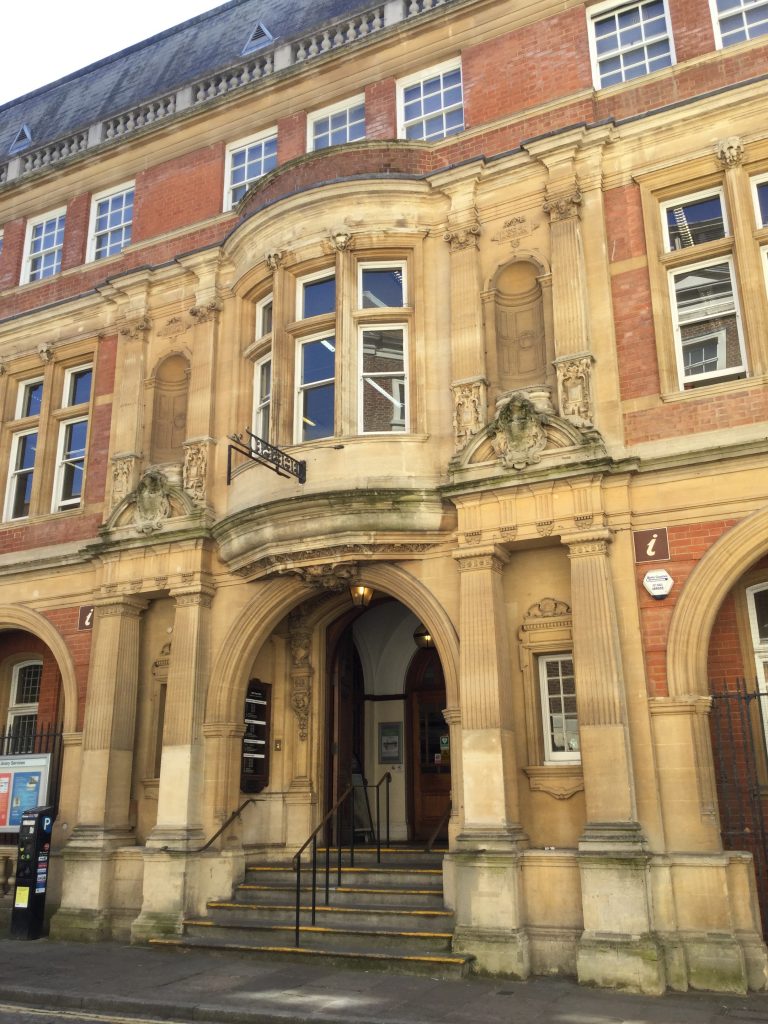
Bibliography
The Private Palaces of London : Past and Present
The Writers’ and Artists’ Yearbook
Online Information Library
Library members can use the various free resources in the Online Information Library. Please note that Ancestry is only accessible from library premises. Ancestry, The Times Digital Archive and The Times Literary Supplement Historical Archive provided the information for this blog post.
Richmond upon Thames Local Studies and Archive
The Local Studies Library and Archive has a wealth of material about the London Borough of Richmond upon Thames. Materials include newspaper cuttings, local newspapers, Census returns, street directories, council minutes, photographs, prints and much other material. More and more of these resources are being digitised by staff and put online.
Details of material that is held in the Library and Archive can be found on their webpages and the catalogue can be searched online.
Sources and suggested reading
Collection of Ian R. Grant, antiquarian bookseller
A review of E Beresford Chancellor’s The History and Antiquities of Richmond, Kew, Petersham and Ham.
Local History Note on Preserving the View from Richmond Hill
Local History Note on Richmond Public Libraries
Office for National Statistics: the modern Census
A review of E Beresford Chancellor’s The History and Antiquities of Richmond,
Kew, Petersham and Ham.
Routledge and Keegan Paul Archive
St Bride’s Foundation Library
[Fiona Campbell, Library Assistant]
